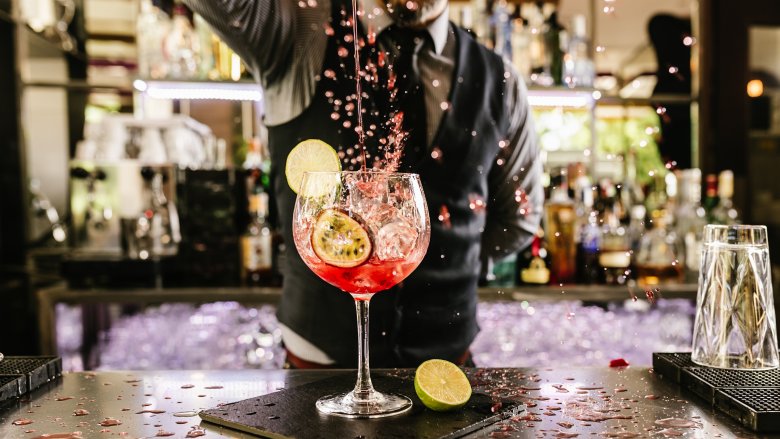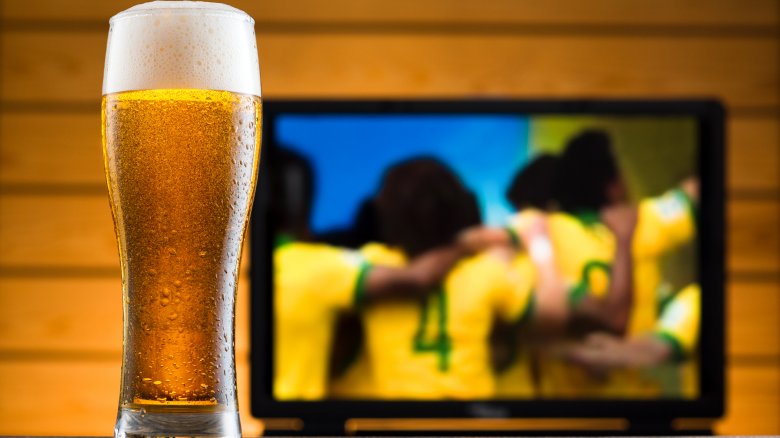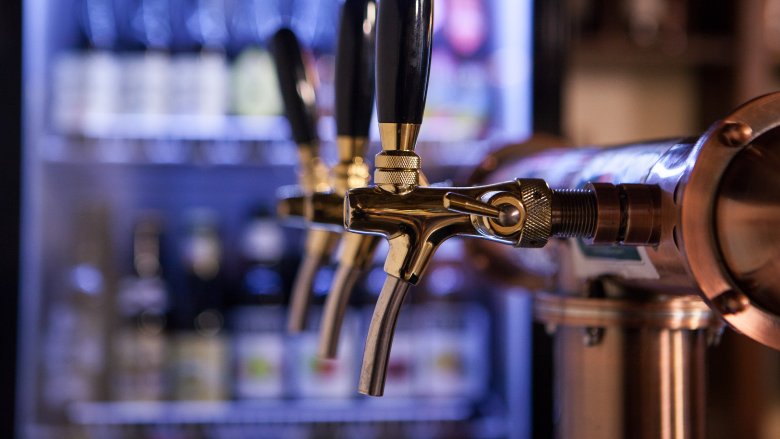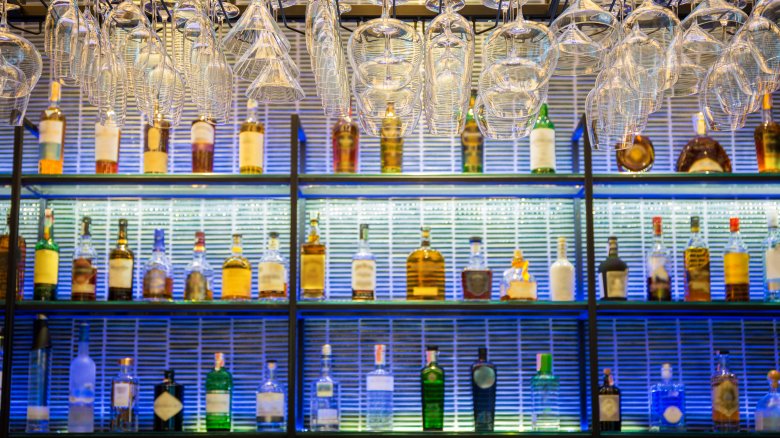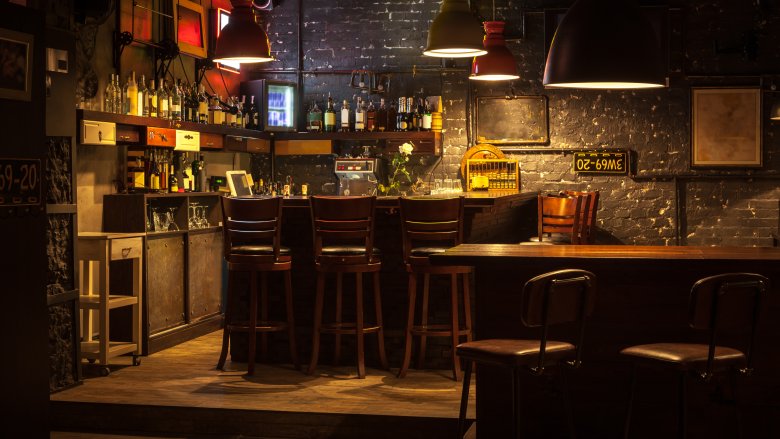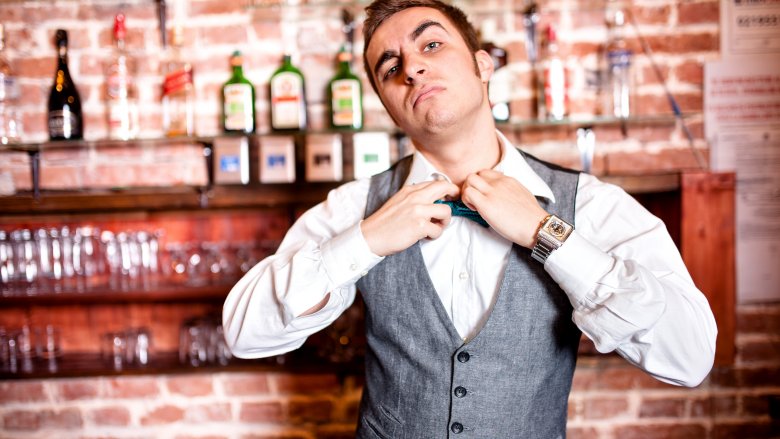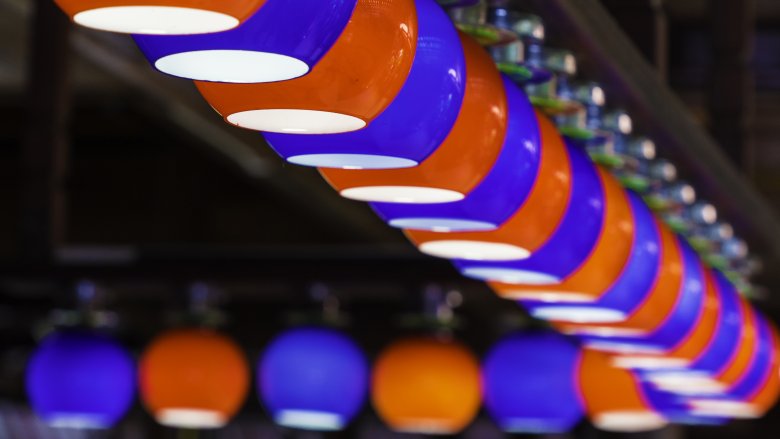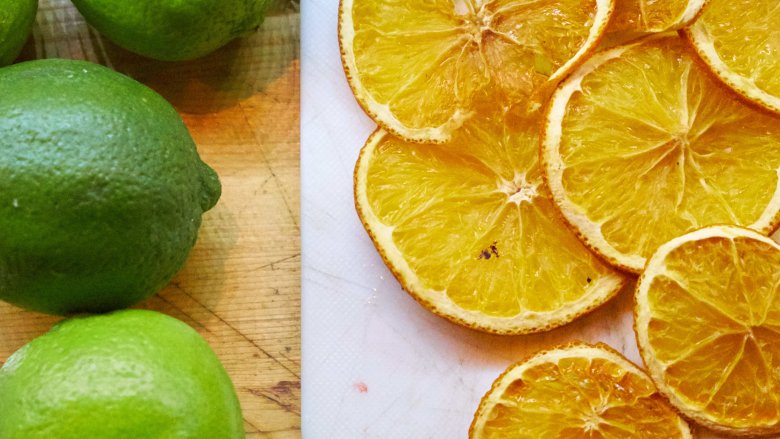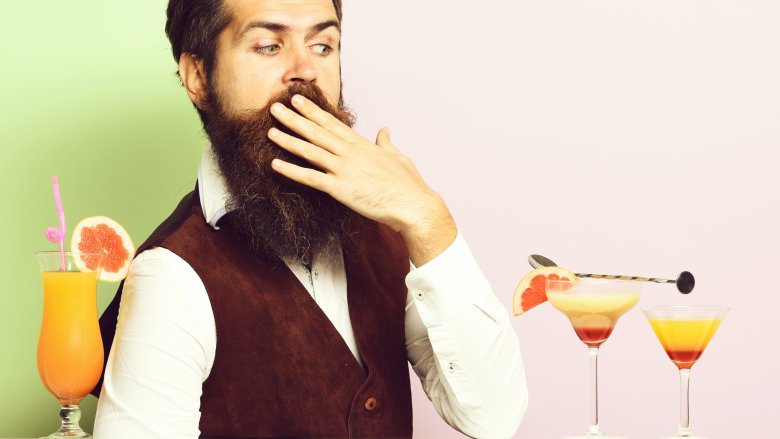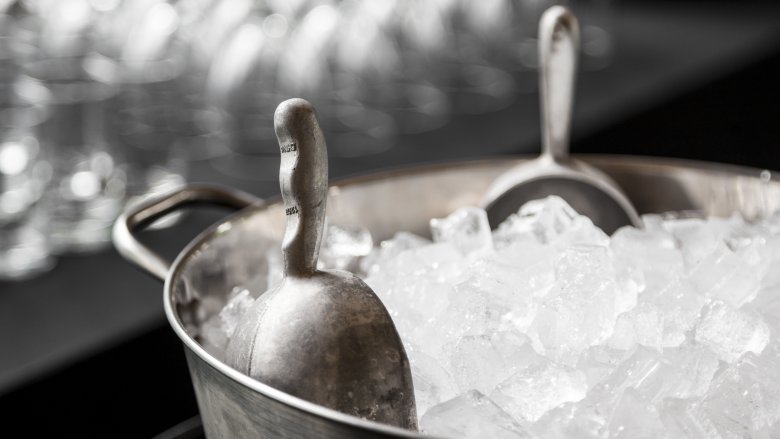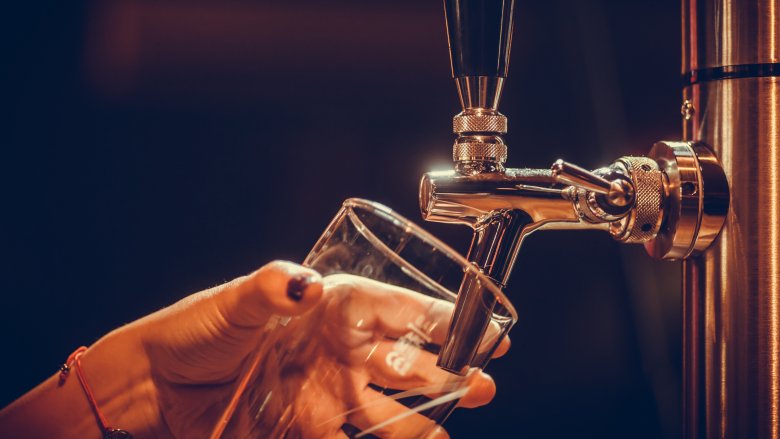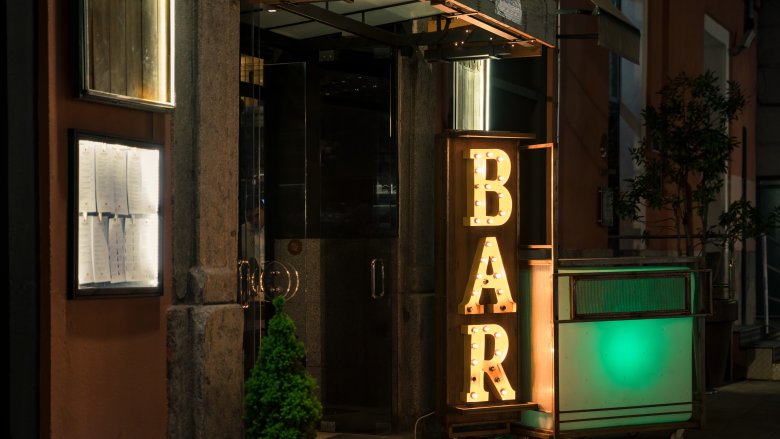Signs You're In A Bad Bar
When you make plans to head out to a bar, there are a few things you always expect. You want the place to be clean and sanitary, you want a pleasant experience in a friendly — but not uncomfortably, overly friendly — place, and you want everyone in the group to be safe. Sometimes it be a tough thing to judge, especially if you're trying out a place for the first time, so let's talk about some warning signs that indicate you might want to turn around and walk back out the door.
There are a ton of televisions
If you're hitting a bar with friends, you want to be able to talk. When the first thing you see when you walk in is a ton of televisions lining the walls, it's a sure sign you've found a place better for watching the game than conversing with your friends.
Nik Manojlovich from Weekend at the Cottage says that's one of the biggest deal breakers for him when it comes to a bar, and the presence of a ton of televisions speaks volumes about what kind of clientele the bar is hoping to attract. "I'd much rather be in a space where people are talking, sharing, and engaging with others," he says, and that's the point of your night out, isn't it?
Beer bottles facing the wrong way
Anyone who's had a skunky beer knows how fast that can put a damper on any night, so how do you know at a glance you're in a place that puts serious stock in keeping the freshest product? James Farley, assistant manager at Berkhamsted's Porters Restaurant, says you should take a look at the beer fridge. All the labels should be facing out, and it's not just for presentation. Stock needs to be rotated with the newer bottles in the back, and making sure they're keeping the labels the right way means they're probably taking the time to stock their fridge properly. Everything is willy-nilly? Who knows how long that beer you're drinking has been sitting there.
Too many types of liquor on display
Marko Mihajlovic is a tour director over at TourMakers, and he says you want to take a look at just how many different types of liquor the bar stocks. While variety is a good thing, you also need to consider the possibility that quality is being sacrificed for quantity. Liquor isn't cheap, after all, and if it seems like the bar has way too many types for the number of customers they serve, he says it's possible they're hoping to skate by with creating a mash-up drink of random liquors and soft drinks.
"They could be just mixing different kinds of liquor and soft drinks while relying on sugar to save the day," he says. "These would usually fall short of what you're expecting."
A sticky or dirty floor
Cleanliness is a given, but it can be tough to tell just how thorough staff is. James Farley, assistant manager at Berkhamsted's Porters Restaurant, says you can take a look at how sticky or dirty the floors are for a gauge of the staff's dedication to cleaning, especially if you're stopping by for lunch. A sticky floor in the afternoon is a sure sign someone's not doing their job, and it can be an indicator of bigger problems.
"That shows the cleaning is not up to scratch, so then I wonder how clean the lines are," he says. The floor is one of the most basic things that should be kept clean and presentable, so if you're sticking to it when you're stopping by for a quick pub lunch, head right back out the door.
Cranky, less-than-professional staff
In most places, the bartender is the face of the establishment. You expect friendly, helpful staff that knows what they're doing behind a bar, and according to Jola Animashaun, an expert in labor relations, you shouldn't just brush off staff members that have a bad attitude or don't seem to want to be there.
A surly, frowning staff isn't just a sign someone might be having a bad day, it could be a sign the bar is run in such a way that no one actually wants to be there. Proper management of staff includes motivating them to do their best, and improper management doesn't just wear on the staff, it makes some all around bad vibes. While it's possible you may have caught someone on a bad day, it's also possible they're reflecting horrible working conditions and you're picking up on that.
Dust on lightbulbs, fixtures, and signs
If you want to know how much effort goes into keeping a clean place, there's a surprisingly easy way to check. TourMakers tour director Marko Mihajlovic says you should check to see if there's dust and dirt that's accumulated on top of light fixtures and inside signs.
"This is usually a very tiny problem, it requires minimal effort to fix, a lot of time to accumulate, and it is so obvious... yet no one took to it," he says. It's an indicator of not just neglect, but neglect over a long period of time, and an inattention to detail that's bound to extend to other parts of the bar.
Funky-looking fruit
The fruit that's going to ultimately make it into someone's drink is another indicator of just how good — and safe — those drinks are going to be. Sneak a peek at the lemons, limes, and other types of garnish, and James Farley, assistant manager at Berkhamsted's Porters Restaurant, says that will give you an idea of just what quality of ingredients are ending up in your glass. Nothing should look odd or off-color, and if it does, you should be wondering what else you'd be drinking.
Take a look at how fruit and garnish is stored, left sitting, and how it's handled, too. A bartender grabbing something with their bare hands and chucking it in a glass isn't just bad, it's potentially dangerous.
The bartenders are touching their face or hair
Bars should be just as cognizant of food safety laws and practices as restaurants and kitchens are, so check out the bartenders. You wouldn't want to see a chef rubbing their eyes, scratching their face, or fixing their hair before plating up your food, so why would you want someone doing those things before fixing you a drink?
This problem is more wide-spread than you may think, and according to The LA Times, bartenders who use the same bare hands they're touching stuff with to make your drink might be posing a serious health risk. A 2014 law changed previous California rules, and stated bartenders would also be bound by legislation that forbid handling food without using gloves, tongs or scoops. Look at it this way: you can never be too sanitary.
Anything but ice in the ice bin
Peek in the ice bin, and if there's anything in there but ice, it's time to find another place to drink. Ice scoops, glasses, hands, and bottles are all potential sources for disease, and it can be a pretty big deal. According to Food Safety Magazine, ice has been linked to outbreaks of gastrointestinal diseases like norovirus, and no one wants that. Ice is going in your drink, after all, and food-grade safety standards should apply to it, too. That means no scooping ice with a glass and definitely no using the ice bin as a cooler. If that's going on, can you imagine the last time the entire bin was emptied and cleaned? Talk about cringe-worthy!
Bartenders are touching the rims of the glasses
Steven Poland over at A Bar Above calls it a rookie bartender mistake, and says no responsible bartender worth their salt should ever touch a glass by the rim. That goes for both serving and cleaning up, and here's why.
If your bartender touches the rim of your glass before serving it to you, you're putting your lips right on whatever he or she just touched. According to BevSpot, it's an offense that can make a bar fail a health inspection, so you know it's a big deal. Poland says it works the other way, too. Bartenders who are cleaning up glasses and pick one up by the rim are exposing themselves to any illness or contagion their patrons may have been carrying, and that's a great way to spread it to themselves or other customers. So take a moment and watch how glasses are handled, and it'll tell you a lot about whether you should pull up a seat, or move on.
Getting into the place is complicated
One big indicator of what kind of bar you're walking into comes before you even set foot inside. While a good bar is going to have a well-lit, well-marked entrance that's just as neat and tidy as you'd expect the inside to be, it's a bad sign when just getting to the front door is complicated. You shouldn't have to walk down unlit alleys, and you definitely shouldn't have to knock.
Anthony Bianco found that out the hard way. He runs the travel site The Travel Tart, and says he was in La Paz, Bolivia with a fellow backpacker when he struck up a conversation with a local couple. When they volunteered to show them a great local bar, they hopped in a taxi. "When I got out, I couldn't see or hear anything resembling a bar," he says. The nervousness really started when his guides had to knock on a steel door, and came to a head when he realized they'd been escorted to a crack den that happened to serve beer. The story had a good ending, but it's an important lesson learned!
